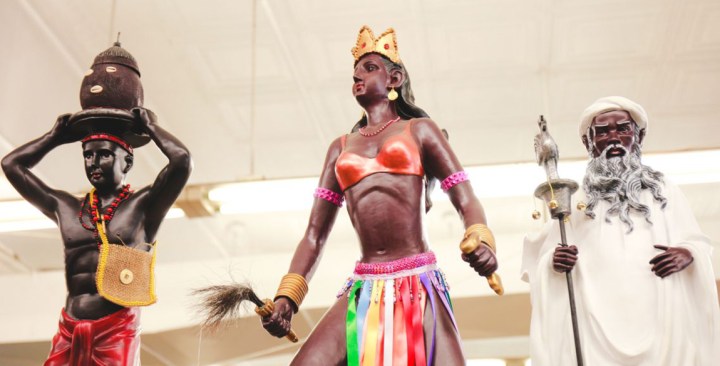A Breakdown of Cuba’s 2019 Letra del Año, the Santero Guide to This Year

Yoruba Statues of Orisha Elegua, Oya, and Obatala at Original Botanica in the Bronx, Photo by Itzel Alejandra Martinez
As we enter a new year, we look for signs of what will come to pass. For many, particularly those who practice La regla de ocha – commonly known as Lukumí or Santería – La letra del año’s a much-anticipated religious event. The letter, an in-depth reading conducted in Havana, acts as a guide to what to expect for the next 12 months. It includes advice and details of offerings given, so that blessings on the horizon can materialize and any pending negative impacts can be lessened. This year’s letter came out on the last day of 2018, with death as a focal point.
La regla de ocha has, at its core, a pantheon of Yoruba deities or orishas who take special interest in their devotees lives. The orishas are consecrated in shrines usually kept in the home, and there are a range of titles and priests, including babalawo, specialist diviners and priests of the orisha, Orunmila, who perform the Reading of the Year and olorisha, also called santerxs who are initiates of all the other orisha. During the annual reading, they determine a ruling orisha and an accompanying orisha. The two deities receive extra consideration and attention throughout the year to help adherents navigate any obstacles they may encounter.
Each year, the cadre of babalawos gather on the last day of December to make offerings on behalf of the world and to divine a letter or odu to guide followers. The odu are the chapters of the divinatory oracle that contains the inherited wisdom, oral knowledge, pharmacopoeia, and remedies for worshippers. Although individual priests in the country and across the world may also divine for themselves or their orisha family at the New Year, people closely follow and widely discuss the official letra del año – which with the help of social media now travels around the world within the first day or two of the year.
In previous years, la Asociación Yoruba de Cuba and la Comisión Organizadora de la Letra del Año Miguel Febles Padrón published two competing letters in Cuba. In 2016, the groups joined forces and continue to work together under the aegis of la Comisión Organizadora de la Letra del Año Miguel Febles Padrón to announce one, united reading. The Comisión is comprised of many senior and respected babalawo from Cuba and around the diaspora and, as is tradition, the most junior, or recently initiated babalawo procures the odu or divination chapter and the entire Comisión then advise on the what the year ahead will foretell.

The odu for 2019 is “Oshe Ogunda,” which arrives with warnings of “Ikú,” translatable as “death” – a term that can refer to a variety of things, including the physical passing but also loss in its wider and symbolic senses and meanings. This action is brought on by warfare and bad intentions, and influenced and aided by negative intentions and malevolent workings. While it may sound like doom and gloom, it will not affect everyone in the same way. And it’s important to remember that blessings can come out of loss and change.

The reading for 2019 tells us that Oshú, orisha of survival and God’s expression of love, will defend everyone this year. She’s backed by Ogún, the path-opening warrior orisha of metallurgy and science. Practitioners will now have a square flag made of yellow cloth trimmed with green to hang in the house signaling the orishas’ presence and intercession in their lives. Among the many prescriptions given by Orunmila through the Comisión is the offering of a yam cut into two halves and rubbed with red palm oil, along with a coconut split in two and two candles. This will be placed on the shrine in the adherent’s home or made on their behalf by their religious elders.
Each odu has many refranes – for Oche Ogunda it’s “lo que se deja no se vuelve a recoger,” which basically says you should not go back to pick up what you have left behind. This can apply to many different personal circumstances (ex: it might not be the best time to get back with your ex). The advice released so far also warn about gastrointestinal issues, and that any issues in these areas shouldn’t go ignored; you should go to a doctor.
Oche Ogunda also warn of an increase in sexually transmitted infections and to take necessary precautions and decisions. The divination speaks of problems with and a downturn in agriculture, as well as problems with water encroachment, flooding and coastal erosion, increased conflict over migrations, and the possibilities of all sorts of natural disasters.
This year, the recommendations are for a return to organic and biologically safe and diverse ways of farming that do not rely on excessive use of chemicals or potential toxins, to not self-medicate, and to lead an unblemished moral and spiritual life. Adherents in Cuba and around the world will apply these recommendations to their spiritual practices this year, making sure that they pay attention to Oshún and Ogún to help them conquer any challenges ahead. Oshún’s Catholic syncretism in Cuba is Nuestra Virgen de la Caridad del Cobre, so expect to see la Cachita’s feast day on September 8 to be celebrated with renewed vigor, in the hopes that we will all be triumphant in 2019.
The letter of the year was announced here and will be updated with further information.